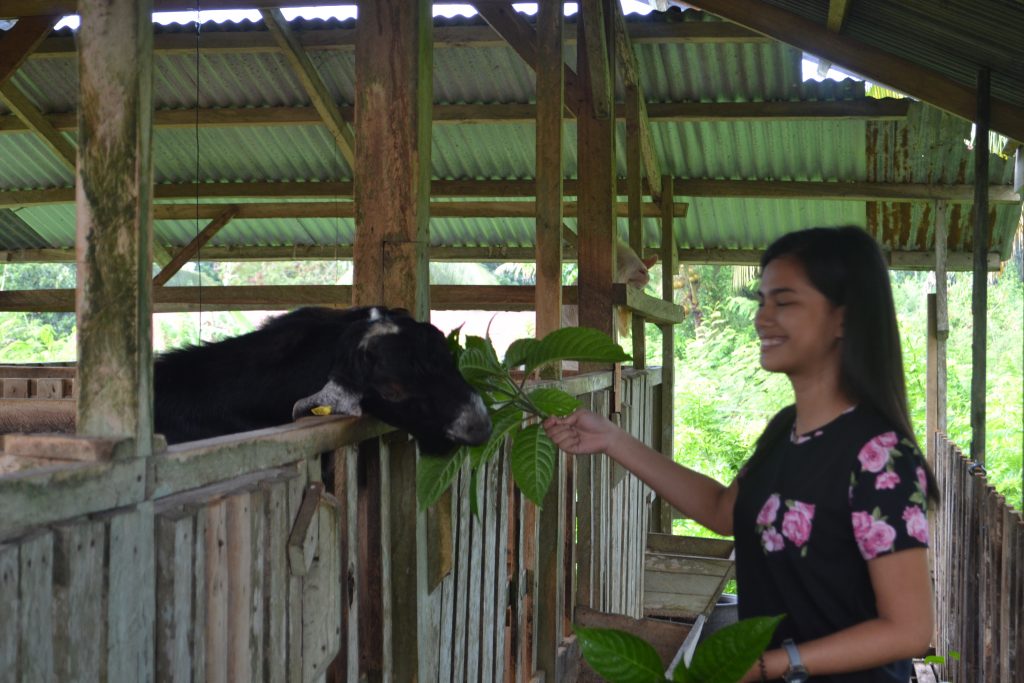
Farming has been a long-standing primary livelihood of most Filipinos. If they want to earn extra income from their farms, they should raise goats. With an increasing contribution to farming income, goats are slowly drawing support and attention both from government and private sectors.
Goats will not only help the Philippine economy but also lessen their farm expenses and help fight malnutrition among children, says Jethro P. Adang, the director of the Davao-based Mindanao Baptist Rural Life Center (MBRLC).
“They may be known as ‘poor man’s cow,’ but goats can be farmers’ source of income should there be crop failure,” he explains. “Since goats have relatively smaller built than cattle and carabaos, they are easier to raise and require a small initial investment. As such, farmers won’t have any problem in integrating raising goats with their existing crop-based farming systems,” he adds.
Goats have been raised since time immemorial. In his book, Goat Husbandry, David Mackenzie wrote: “When man began his farming operations in the dawn of history, the goat was the kingpin of the personal life, making possible the conquest of desert and mountain and the occupation of the fertile land that lay beyond. The first of Man’s domestic animals to colonize the wilderness, the goat is the last to abandon the deserts that man leaves behind him.”
History records showed that goats were considered the first hoofed animals ever tamed. In the Biblical town of Jericho, people kept tame goats as long as 6,000 or 7,000 years before Christ. The ancient Greeks and Romans paid great attention to the rearing of goats. Anyone at all familiar with classical authors will remember how frequently these animals are mentioned, especially in pastoral poems.
According to Adang, there are many advantages of raising goats compared with other dairy livestock. For one, they multiply faster than cattle or carabaos. “Before a goat turns three years old, she can have given birth to as many as five kids,” he says.
Another advantage: goats require less feeds than cows and carabaos. “About 10 native goats can be fed on the feedstuffs sufficient for one cow,” Adang claims. “About 6-7 purebred dairy goats can be fed on what one dairy cow needs.”
Although it is a small animal, “a purebred goat can produce as much as 4 liters of milk if the doe is given a ration that meets all of her nutritional requirements,” points out Adang.
Unknown to many, goat’s milk is nearest to mother’s milk. “Thus, it has a wide variety of health benefits,” wrote Dr. Edwin C. Villar in an article, “The ‘udder side’ of goat.” “Goat milk has smaller, well-emulsified fat globules, without agglutinin protein hence easier to digest. This is very ideal for infants and senior citizens which constitute approximately 16% of the population of the country.”

That’s not all. “Goat milk has higher levels of amino acids and significant proportion of medium chain triglycerides, recognized as highly beneficial to a number of health issues, and has higher amounts of vitamins and minerals with greater bioavailability,” Dr. Villar wrote.
A research done by the Department of Science and Technology (DOST) showed that goat’s milk per 200 milligram serving can provide 20% of the daily requirements for calcium, 4% for vitamin A, and 8% for iron. Interestingly enough, goat milk is easier to digest and assimilate in the human body with every 3.8 times more calcium than a mother’s milk.
In the cosmetic industry, goat milk is the new trend. “It has naturally occurring alpha-hydroxyacids which is a good skin exfoliant,” Dr. Villar reported. “It is also high in capric, caprylic, and caapronic acids, which makes it a good moisturizer with good fats (the medium chain fatty acids) that keeps the skin’s oil in balance.”
Adang says successful raising of dairy goats starts with the right kind of breed. Highly recommended is the Anglo-Nubian goats. Its average weight is about 65 kilograms. Some are born with horns while others are hornless. It has long drooping ears, distinct Roman nose and prominent forehead. Some strains are predominantly black, others brown, and the coat is long.
“Anglo-Nubian goats produce an average of two liters of milk daily,” Adang says. The butterfat content is about 5.6% (in comparison, the common goat has a butterfat content of 46%). This breed, a native of Northeastern Africa, is found to have a satisfactory performance in the country.
“If you cannot secure purebred stock, you can start with the best female goats available in your area,” Adang says. “Mate them with purebred or upgraded stock. Then, select only their offspring and discard the undesirable ones (you can either sell them or butcher them for meat). Continue this procedure each year, and you will have desirable goat stocks.”
But here’s a timely thought from Bryan Regencia, a recipient of Gawad Saka for small animal raising in 2013. His Sagana Farm, as he calls it, is located in Mati City, Davao Oriental. He started raising goats in 2008.
“Most goat farmers in the Philippines raise native goats or crosses because they believe they are cheaper to raise compared to purebreds,” he said. This is true when it comes to meat production. But for dairy production, he bats for purebreds.
In 2011, he shifted into raising well-selected, purebred Anglo-Nubian goats. “Unlike other dairy-type goats,” he said, referring to Saanen, Toggenburg and French Alpine, “the Anglo-Nubian breed has Asian, Middle eastern, and Western blood in them.” Which is why, he added, they are good for milk production.
There are several ways of raising dairy goats. The MBRLC, touted as Davao del Sur’s goat capital, recommends zero grazing. In this system, the goats are not allowed to graze in the field. Instead, the pasture area is planted to recommended varieties of grasses and legumes.
The forages are cut by the strips and carried to the goats’ house. The goats are completely confined in their assigned pens. Although this system is recommended mainly for milk production, it has become a popular method also in meat production.
Dairy goats need a simple house for protection. It can be constructed using local materials available in your area. Bamboo slats, ipil-ipil poles, and coconut leaves make fine flooring, siding and roofing, respectively. Nipa or cogon grass can also be utilized for roofing.
A mature goat needs a maximum floor space of 4 by 5 feet or 20 square feet. The floor is raised by about 4 feet off the ground to facilitate easy cleaning and manure collecting. A fact to remember: goats don’t like rain and damp places.
Dairy goats should be fed nutritious feeds on a year-round basis. But the question is, what kind of forages should they be given? Native grasses decline fast, have low volume per hectare, inadequate for high stocking rates, and do not respond well to fertilization.
Obviously, the solution is to plant new, improved, and more efficient grass and legume species, which are palatable to goats. MBRLC recommends the following legumes: Flemingia macrophylla, Desmodium rensonii, Indigofera anil, and Gliricidia sepium.
“A combination of these legumes provides three advantages,” Adang says. “They improve milk production and chevon quality of the goats, aside from making the soil fertile and helping prevent soil erosion.”

The MBRLC has been raising dairy goats since the 1970s. Today, people come to the center not only to undergo training on raising goats but also buying breeding stock. It sells ready-to-breed purebred Anglo-Nubian at P10,000, for the first 20 kilograms. If a goat is more than 20 kilograms, the buyer adds P1,000 per additional kilogram.
And there’s money in selling goat milk. At the MBRLC, fresh milk is sold at P30 (350 milligrams), P35 (500 milligrams), and P65 (one liter). When mixed with chocolate and little sugar, the cost is P35, P45, and P75, respectively. “With fresh goat milk, you can be sure that the milk your child is taking is free from harmful chemicals,” Adang assures. (To be concluded)






